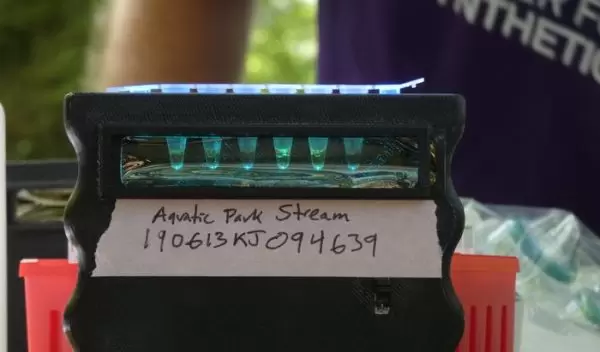
New DNA computer assesses water quality
Synthetic biologists at Northwestern University have developed a low-cost, easy-to-use, hand-held device that can let users know -- within minutes -- if their water is safe to drink.
The new device works by using powerful and programmable genetic networks, which mimic electronic circuits, to perform a range of functions.
Among the DNA-based circuits, for example, the researchers engineered cell-free molecules into an analog-to-digital converter (ADC), a circuit type found in nearly all electronic devices. In the water quality device, the ADC circuit processes an analog input (contaminants) and generates a digital output (a visual signal to inform the user).
The U.S. National Science Foundation-fostered research appears in the journal Nature Chemical Biology. "This project is an illustration of the incredible possibilities provided by discoveries in synthetic biology," said David Rockcliffe, a program director in NSF's Division of Molecular and Cellular Biosciences.
Equipped with a series of eight small test tubes, the device glows green when it detects a contaminant. The number of tubes that glow depend on how much contamination is present. If only one tube glows, the water sample has a trace level of contamination. But if all eight tubes glow, the water is severely contaminated. The higher concentration of contamination leads to a higher signal.
"We programmed each tube to have a different threshold for contaminations," said Northwestern's Julius Lucks, who led the research. "The tube with the lowest threshold will light up all the time. If all the tubes light up, there is a big problem. Building circuits and programmable DNA computing opens up many possibilities for other types of smart diagnostics."
The new system builds off previous work. In that research, the team introduced ROSALIND (RNA Output Sensors Activated by Ligand Induction), an in vitro biosensing system named after chemist Rosalind Franklin, that detected 17 contaminants in a single drop of water. Now, in the new version -- dubbed ROSALIND 2.0 -- Lucks and his team have added a "molecular brain."
"The initial platform was a biosensor, which acted like a taste bud," Lucks said. "Now we have added a genetic network that works like a brain. The biosensor detects contamination, but then the output of the biosensor feeds into the genetic network, or circuit, which works like a brain to perform logic."
Researchers freeze-dried the reprogrammed "molecular brains" to become shelf-stable, and put them into test tubes. Adding a drop of water to each tube sets off a network of reactions, ultimately causing the freeze-dried pellet to glow in the presence of a contaminant.


